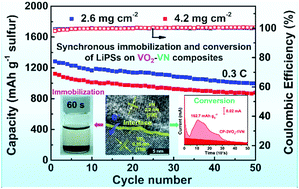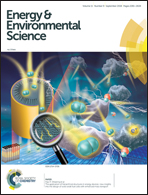Synchronous immobilization and conversion of polysulfides on a VO2–VN binary host targeting high sulfur load Li–S batteries†
Abstract
Lithium–sulfur (Li–S) batteries are deemed as one of the most promising next-generation energy storage systems. However, their practical application is hindered by existing drawbacks such as poor cycling life and low Coulombic efficiency due to the shuttle effect of lithium polysulfides (LiPSs). We herein present an in situ constructed VO2–VN binary host which combines the merits of ultrafast anchoring (VO2) with electronic conducting (VN) to accomplish smooth immobilization–diffusion–conversion of LiPSs. Such synchronous advantages have effectively alleviated the polysulfide shuttling, promoted the redox kinetics, and hence improved the electrochemical performance of Li–S batteries. As a result, the sulfur cathode based on the VO2–VN/graphene host exhibited an impressive rate capability with ∼1105 and 935 mA h g−1 at 1C and 2C, respectively, and maintained long-term cyclability with a low capacity decay of 0.06% per cycle within 800 cycles at 2C. More remarkably, favorable cyclic stability can be attained with a high sulfur loading (13.2 mg cm−2). Even at an elevated temperature (50 °C), the cathodes still delivered superior rate capacity. Our work emphasizes the importance of immobilization–diffusion–conversion of LiPSs toward the rational design of high-load and long-life Li–S batteries.



 Please wait while we load your content...
Please wait while we load your content...